Looking to make an inexpensive, homemade bathroom cleaner spray without toxic chemicals? This blog is for you! No more buying multiple products to clean the bathroom. Here’s how to make the best bathroom cleaner with just 3 ingredients and 2 minutes!
Simply whisk together baking soda, castile soap, and water for a simple and effective DIY cleaning spray that can be used on all bathroom surfaces.
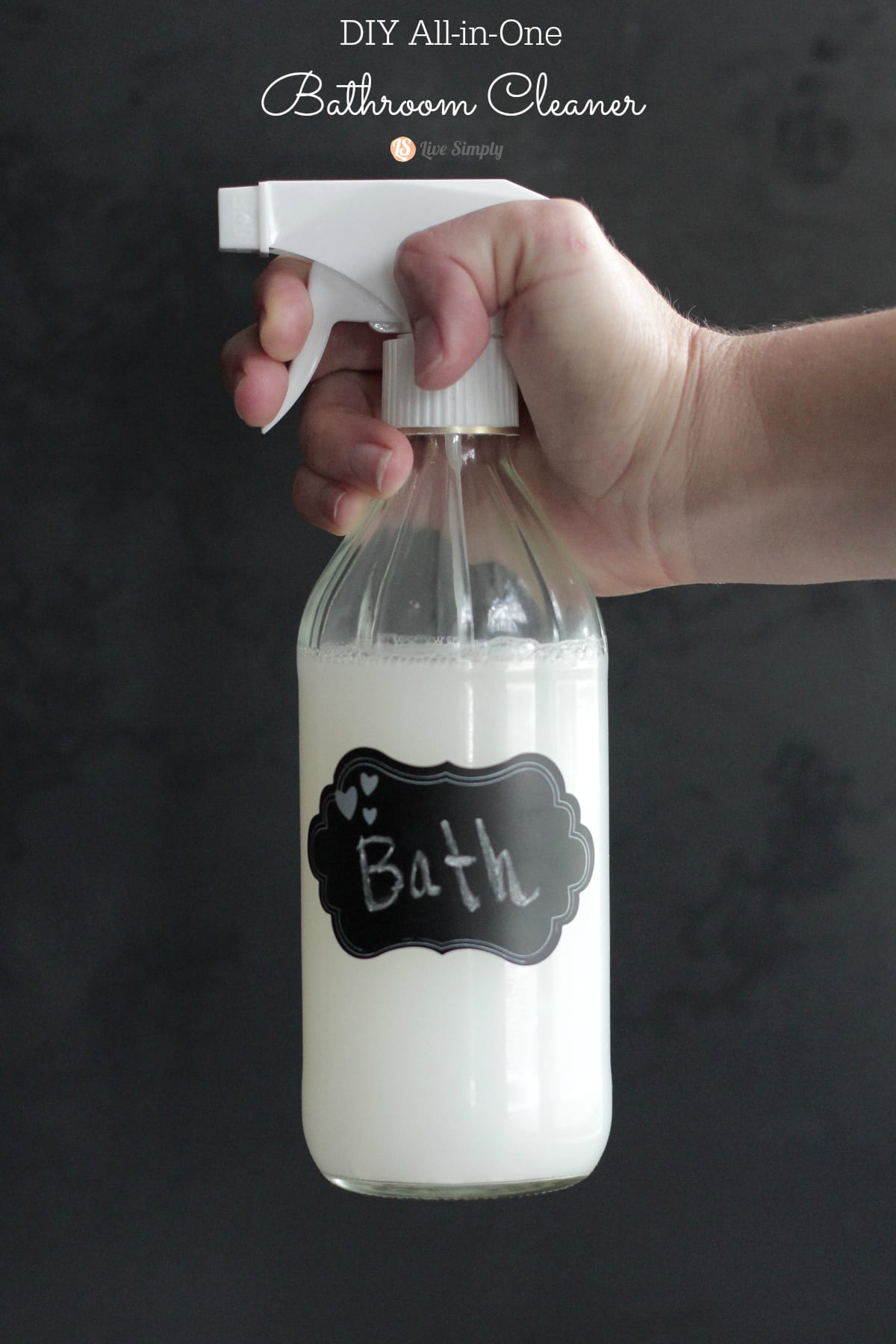
Want to Save This Article?
Enter your email & I’ll send it straight to your inbox. And you’ll get new recipes & tips each week.
In this blog, I’m outlining the exact steps to make the best all-purpose bathroom cleaner.
The Story Behind This Recipe…
- In 2014, I took the kids to a birthday party. The true highlight of the party was more than just a piece of cake or presents; it was the mom’s therapy.
- Each mom shamelessly chatted about the pile of dishes on the kitchen countertop at home and the never-ending laundry pile. There were moments of laughter about potty training and home messes—therapy at its finest.
- One topic we discussed was how hard it is to keep a bathroom clean with little kids at home. Boy, did this resonate with me!
- Since having children, we’ve made drastic changes to our lifestyle. Gone are the days of freezer pop-tarts and Tide laundry soap (trust me, that was a hard habit to quit.)
- As a family, we’ve embraced real food and natural cleaning, but under one condition: homemade alternatives must be more effective (or better tasting and satisfying in the case of food) than the toxic alternatives.
- This quest has led me to homemade scrub cleaner, homemade laundry detergent, all-purpose cleaner, and so much more. It’s been freeing.
- So what’s a mom to do with a forever changed bathroom and the need for an effective homemade bathroom cleaner? Experiment, of course!
- After much experimenting, I created an all-in-one homemade bathroom cleaner that’s simple and effective. A cleaner that works so effectively, I must share for the sake of all the parents out there!
- Think of this cleaner as bathroom therapy and mess relief in a little homemade bottle. Over the years, many people have made and loved this cleaner. I hope you will, too!
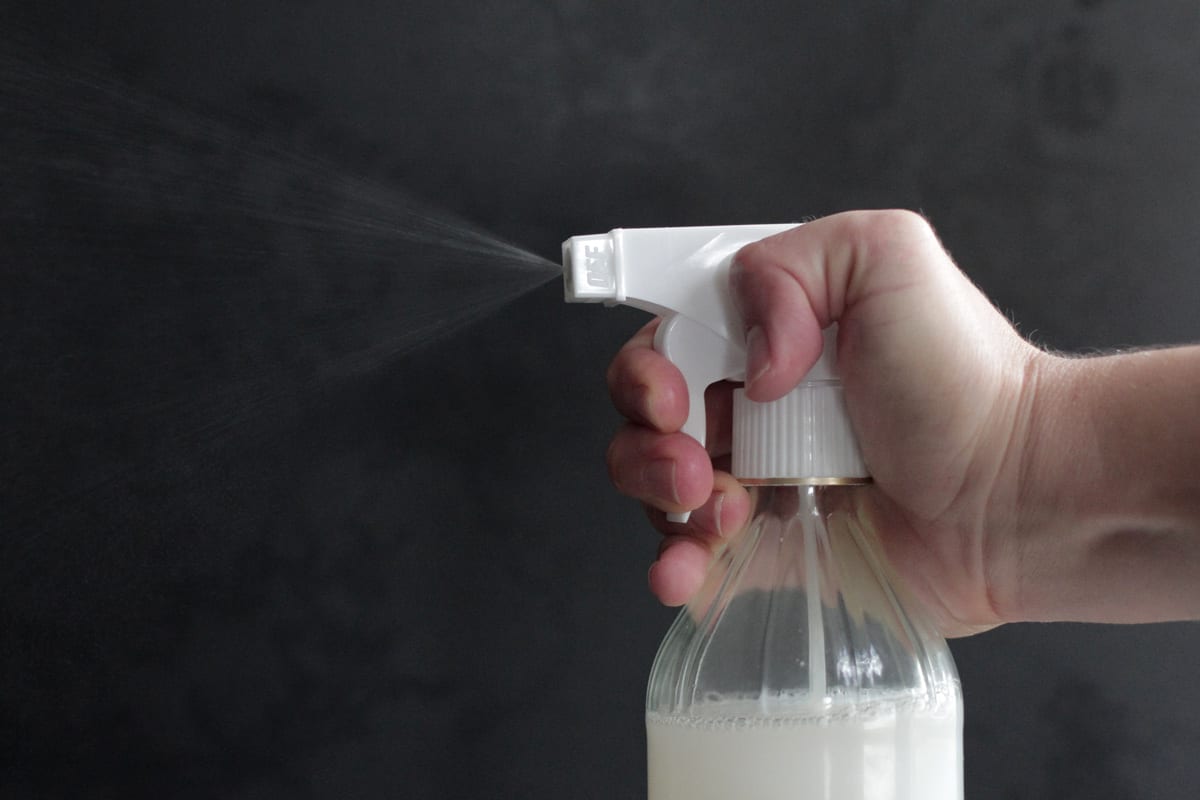
Key Takeaways
- All-Purpose Cleaner – This cleaning spray is an all-in-one product, because it literally does it all! It’s one of the best homemade bathroom cleaners for this reason.
- Simple Ingredients – All you need is a few natural ingredients: castile soap, baking soda, water, and (optional) essential oils.
- Shelf Life – If you use distilled water (found in any grocery store), this recipe will last for up to 1 month.

Before You Get Started: Ingredients & Tools
- 2 tablespoons Liquid Castile Soap
- 1 tablespoon Baking Soda
- 2 cups Warm Water – Distilled water is the best option for safety reasons, which you’ll find at any grocery store.
- 30 drops Tea Tree Essential Oil (Optional for extra cleaning power)
- 20 drops Sweet Orange Essential Oil (Optional, or use your favorite essential oil for scent)
- 16-ounce Spray Bottle
Ingredient 1: Liquid Castile Soap
- Ancient & Natural – Castile soap is a plant-based soap made from vegetable oils (olive, coconut, palm) and plant oils. It’s been around since the 11th century and was first made in the Aleppo of the Levant region (modern-day Syria). The Crusaders learned about this soap, which was eventually brought to Europe and spread worldwide. Today, find it in most grocery stores.What is castile soap?
- Multiple Uses – Castile soap is versatile (you can use it to make multiple DIY cleaners and body products), inexpensive, and completely natural.
- Incredible Cleaning Power – Castile soap quickly picks up dirt, bacteria, and cleans grime from surfaces. It doesn’t kill bacteria, but it does easily lift and remove bacteria from surfaces. Antibacterial products, on the other hand, are designed to kill bacteria (not lift and remove the bacteria from the surface, as soap does).
- Learn More: 7 castile soap cleaning recipes & 24 castile soap uses for body and cleaning.
Ingredient 2: Baking Soda
- Underrated – Baking soda is a cheap, powerful, underrated cleaning ingredient.
- Incredible Cleaning Power – It cleans, deodorizes, and lifts odors, brightens and removes stains and soap scum, and freshens.
- Many Cleaning Uses – When used in the bathroom, baking soda is a deodorizer to lift stains and smells trapped on bathroom surfaces (and we all know how sticky a bathroom can get!). Also use baking soda to clean a toilet, remove stubborn dirt and grease, and lift odors.
- Learn More: 19 Frugal Cleaning Hacks With Baking Soda
Ingredient 3: Warm Water
- Dissolves Baking Soda – Baking soda needs warm water to dissolve and make a spray cleaner.
- Distilled Water is Best – Tap water may contain pathogens that quickly grow in a water-based solution. For this reason, it’s always best to use distilled water, which has been heated to such a degree that the process kills bacteria and limits the ability for bacteria to grow in your homemade cleaning product. Distilled water also doesn’t contain any minerals, so it won’t leave behind mineral deposit spots on surfaces.
- How to Find Distilled Water- You can buy a gallon of distilled water at any grocery store.
- Learn More: How to Safely Make Homemade Cleaners
Ingredient 4: Essential Oils
- Cleaning Properties – Tea tree and orange essential oils are added to this recipe for their cleaning properties.
- Optional – If you don’t have essential oils on hand, or don’t want to buy essential oils, you can skip them.
- Unscented Option – If you skip the oils, the cleaner won’t have any scent (unless you use scented castile soap).
- Use Your Favorite Essential Oils – You could also use other essential oils, like lavender essential oil, grapefruit essential oil, peppermint essential oil, or eucalyptus essential oil.
- Learn More: Natural Cleaning with Essential Oils 101
Tool: 16-Ounce Spray Bottle
- Use any leftover 16-ounce spray bottle to make and store this recipe. If the spray bottle was previously used for a different cleaner, make sure it’s been thoroughly rinsed to avoid any chemical combinations with the previous cleaner.
- I’ve been using glass spray bottles from Amazon (this brand) for years. You can also make your own spray bottle with a leftover vinegar bottle and spray nozzle.
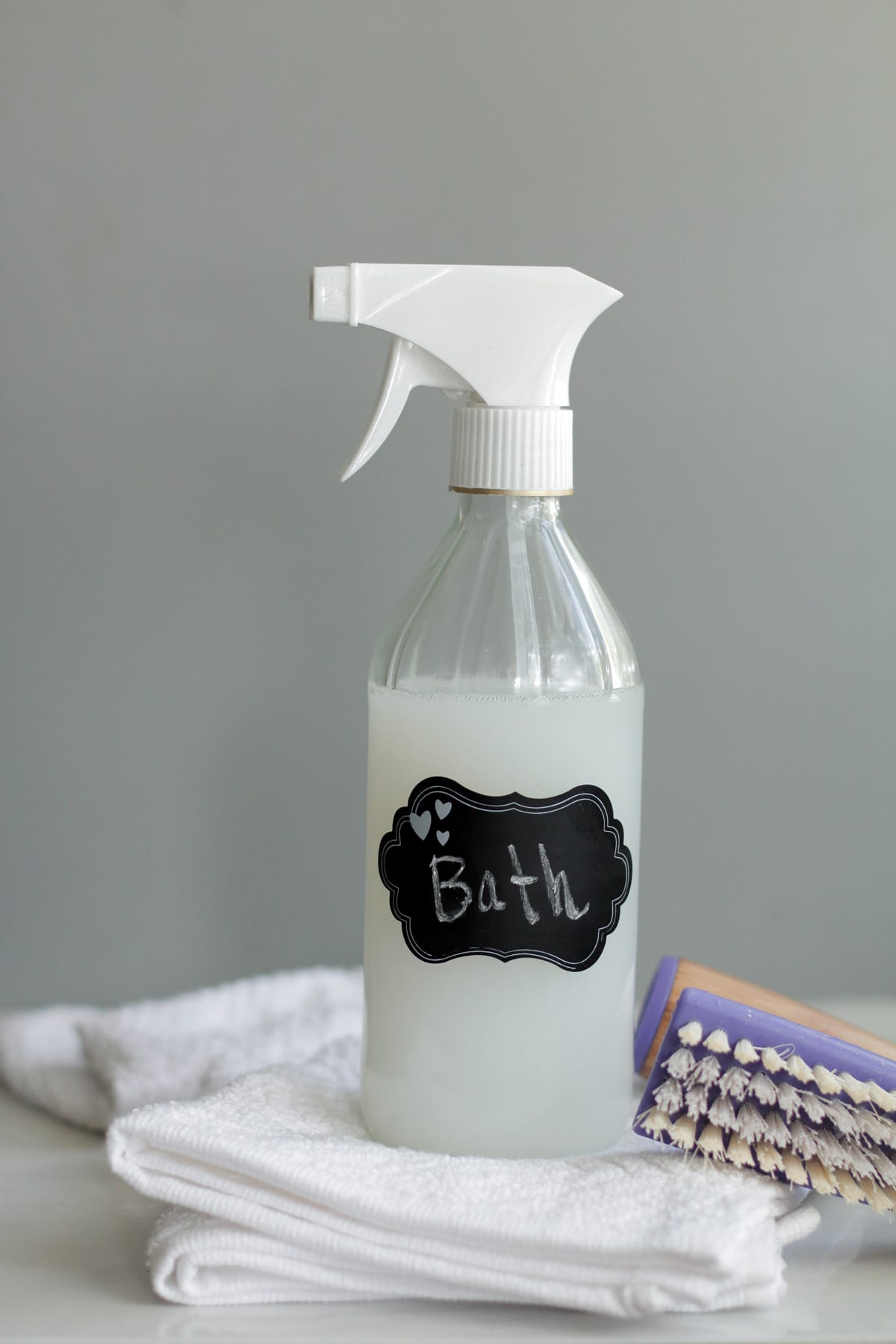
How to Make Homemade Bathroom Cleaner: Step By Step Guide
Making this recipe is super easy. It only takes 2-5 minutes. As soon as you make the spray, it’s ready to be used.
- Step 1 Add Warm Water and Baking Soda – Pour the warm water (heat the water in the microwave or on the stove-top until warm) into the spray bottle, followed by the baking soda. Shake the bottle to combine the ingredients.
- Step 2 Add Castile Soap and Essential Oils & Shake – Add 2 tablespoons of castile soap and essential oils, gently shaking the bottle to combine the ingredients.
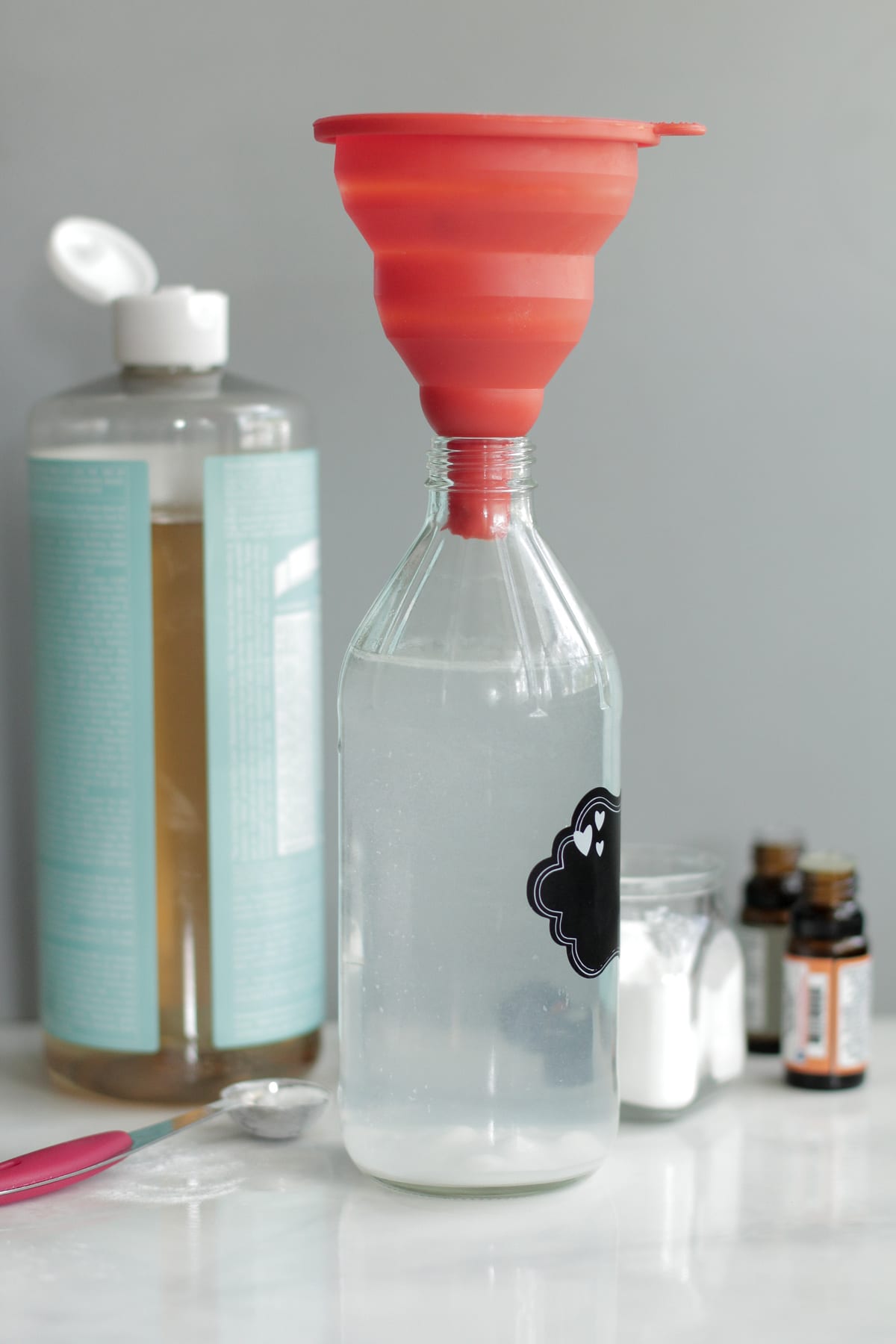
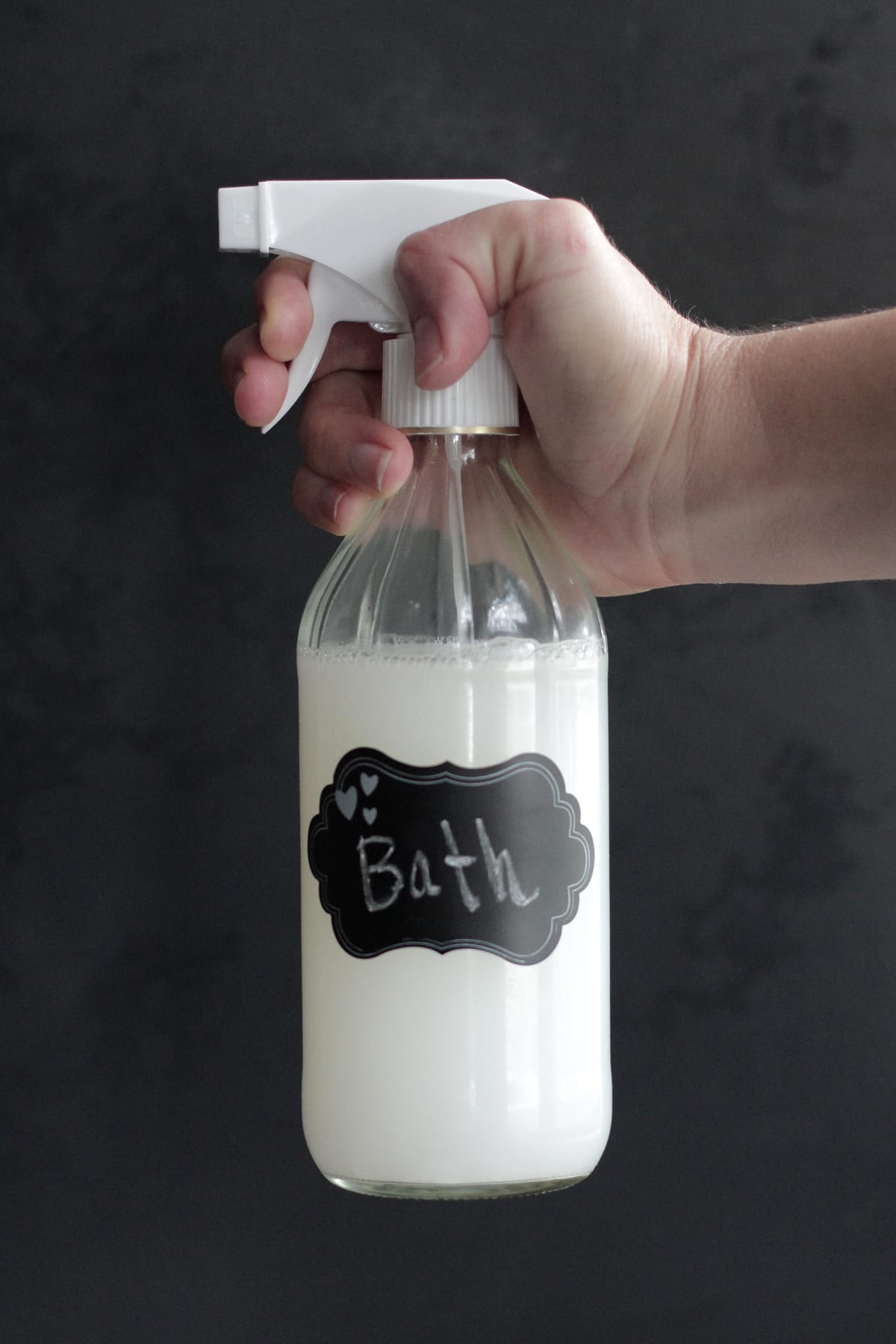
How to Use
This spray truly does it all! The simple ingredients clean up dirt, grease, odors, or mystery liquids that may be lurking inside your bathroom. Here’s where and how to use this cleaner…
- tub (I also love this tub scrub)
- shower
- tile
- grout
- toilet (and I love this toilet bowl cleaner)
- sink
- bathroom fixtures (faucet, shower head, etc.)
- tile floors
- This cleaner also works wonderfully as a stain remover for carpets and rugs! Spray on the stain, then wipe clean. I also love this stain remover spray.
To Clean Surfaces – Shake the bottle before using. Spray the surface, allow the solution to rest for a minute, then wipe with a damp cloth. Rinse the cloth as needed, and wipe the surface with the damp cloth until clean.
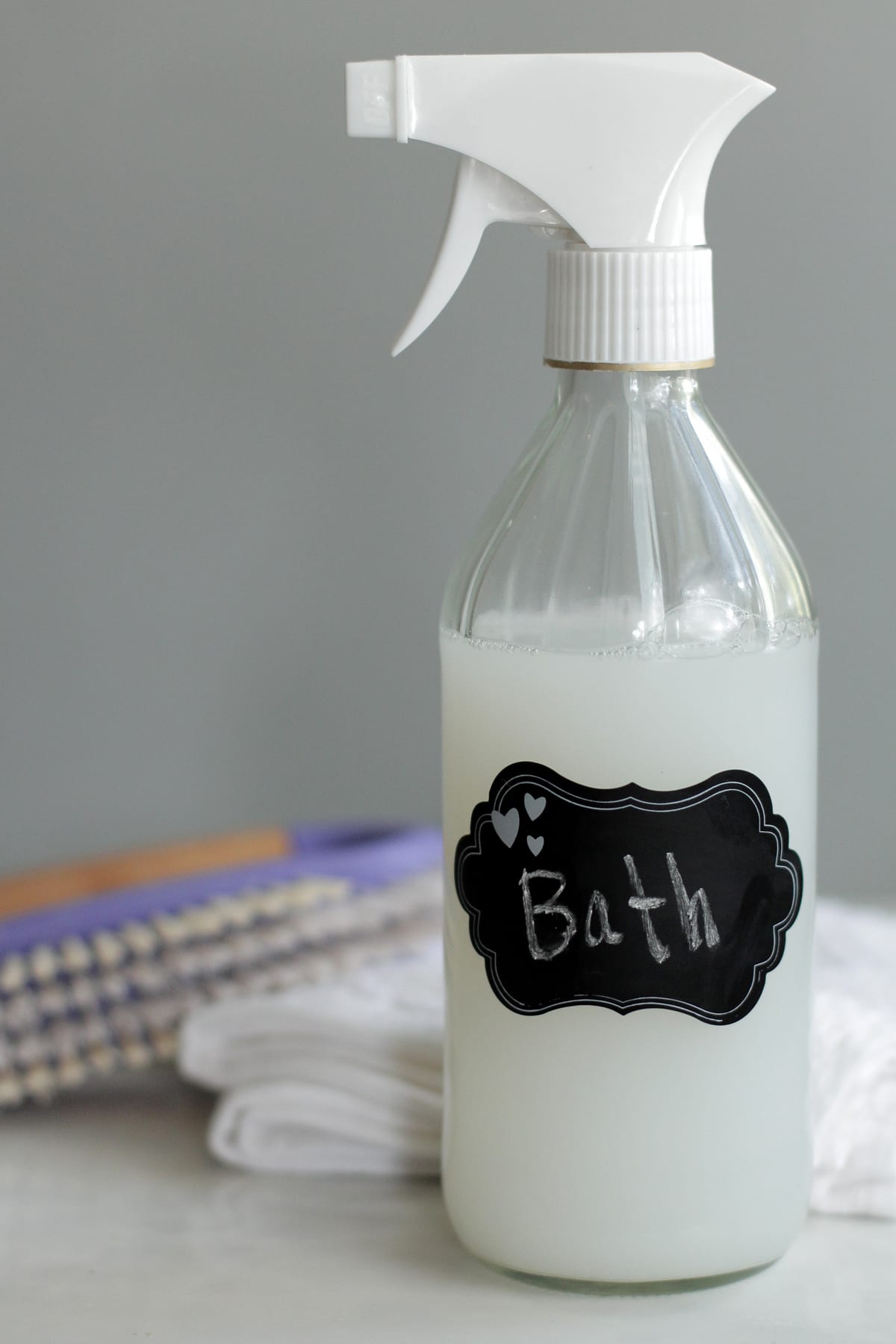
How to Store
- 1 Month – Since this product contains water, natural ingredients, and no preservatives, it’s best to store this product for only a few weeks (up to 1 month if using distilled water).
- Use Your Senses – If the cleaner ever smells off, has black spots or fuzzy growth, toss the cleaner and make a new batch. I’ve never had this happen, but it’s worth mentioning just for safety reasons.

What to Avoid Doing
- Vinegar & Baking Soda – Never add vinegar to this recipe. Vinegar and baking soda cancel each other and will result in an ineffective product. Learn more about this reaction.
- Use Tap Water – Tap water may contain pathogens that quickly grow in a water-based solution. Distilled water is always the safety option for homemade cleaner. Learn about homemade cleaners and safety.
- Use Hard Water – When hard water (from the tap) and castile mix together, the end result is a film left on surfaces. While this isn’t harmful or permanent, it is annoying. To avoid this, use distilled water.
- Use Room Temperature Water – The baking soda needs to be mixed with warm water to properly dissolve. Warm the water in the microwave or stove-top before adding to the mixture. If you’re concerned about the glass spray bottle breaking (or if using a plastic spray bottle), dissolve the water and baking soda in a separate bowl, then add to the spray bottle of choice once it cools.
How to Prevent Common Recipe Problems
- Hard Water & Castile Soap – Some folks find castile soap leaves behind a cloudy surface film, like a white residue. This issue is caused by the castile soap interacting with hard water, and the surface may need to be wiped down a few times with a damp washcloth. Another way to avoid this issue is to use distilled water. Or, switch over to an All-Purpose Spray with Vinegar.
- Baking Soda Clogging The Spray Bottle – Use warm enough water to dissolve the baking soda. This solution should prevent the spray bottle nozzle from clogging. I’ve had great success with these bottles over the years.
- Separation & Settling – This recipe is a natural product, so expect some settling and separation. Shake the bottle between uses.
FAQs
- I had problems with the baking soda clogging up my sprayers and ruining them. Any suggestions? Try dissolving the baking soda with really hot water first, then adding the solution to the spray bottle. This should prevent such an issue. Another option is to use less baking soda.
- Could I use different dish detergent than castile soap for bathroom cleaning? Yes, you can use any natural dish soap or your favorite dish soap instead of the castile soap.
- Could you please write a recipe for natural daily shower spray? My favorite option is vinegar mixed with about 30-60 drops of tea tree essential oil for the mold. Combine the two ingredients in a spray bottle. This recipe is found in my Natural Cleaning Course.
- Would it be alright to substitute grapefruit essential oil instead of the orange in the bathroom cleaner recipe? Yes, you can use any essential oil. If you have pets or children at home, do you research on the safest options (many essential oils can’t be used around cats or small children).
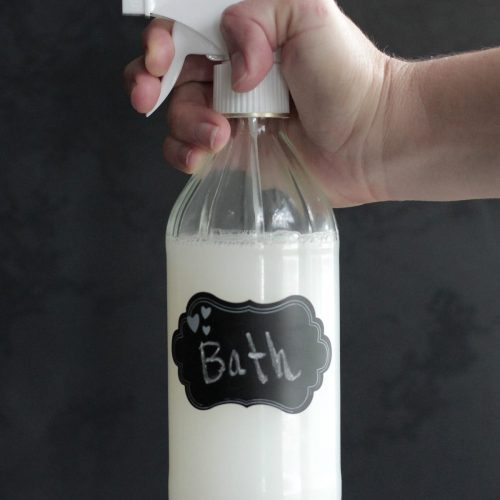
All-In-One Homemade Bathroom Cleaner Recipe
Equipment
Ingredients
- 2 cups warm water distilled water is best
- 1 tablespoon baking soda
- 2 tablespoons castile soap
- 30 drops tea tree essential oil (optional)
- 20 drops sweet orange essential oil (optional, or your favorite essential oil for scent)
Instructions
- Warm the water in the microwave or on the stove-top.
- Pour the warm water into the bottle, followed by the baking soda. If you're concerned about the glass spray bottle breaking (or if using a plastic spray bottle), dissolve the water and baking soda in a separate bowl, then add to the spray bottle of choice once it cools.
- Shake the bottle to combine the ingredients. Add the castile soap and essential oils, gently shaking the bottle to combine.
How to Use:
- Use this spray to clean the tub, tile, toilet, sink, and even floor (particularly around the toilet.) Spray the surface, allow the cleaner to sit for a minute, then wipe with a damp cloth. Rinse the cloth as needed.
Notes
FREE RECIPE DOWNLOAD
4 Must-Make Natural Cleaners for Your Home
Favorite Bathroom Cleaners
- Homemade Toilet Bowl Cleaner
- How to Naturally Clean & Disinfect Your Toilet
- Homemade All Purpose Spray With White Vinegar (great for mold and mildew or a daily homemade shower cleaner)
- Orange Peel Vinegar Spray (use leftover oranges and lemons to make this all-purpose spray)
- Tub and Sink Scrub
- Window and Glass Cleaner (also works for glass shower doors )
- 6 Homemade Air Freshener Ideas
- How to Make Homemade Floor Cleaner

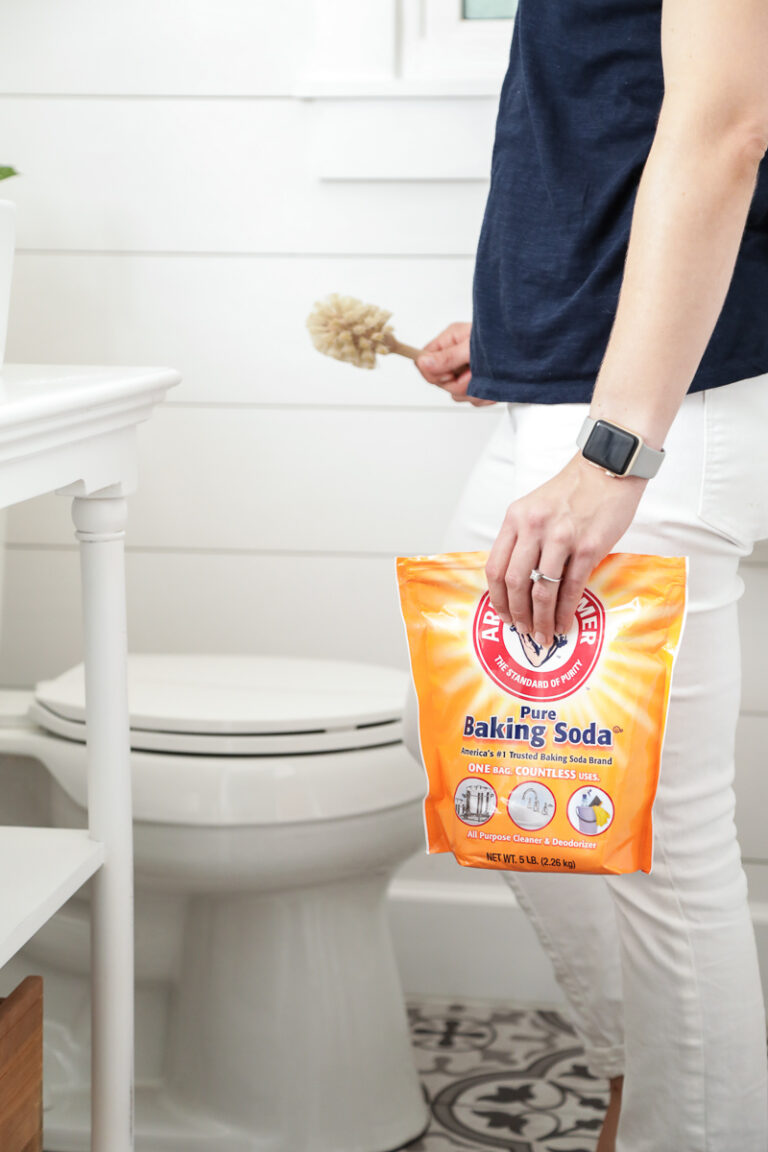
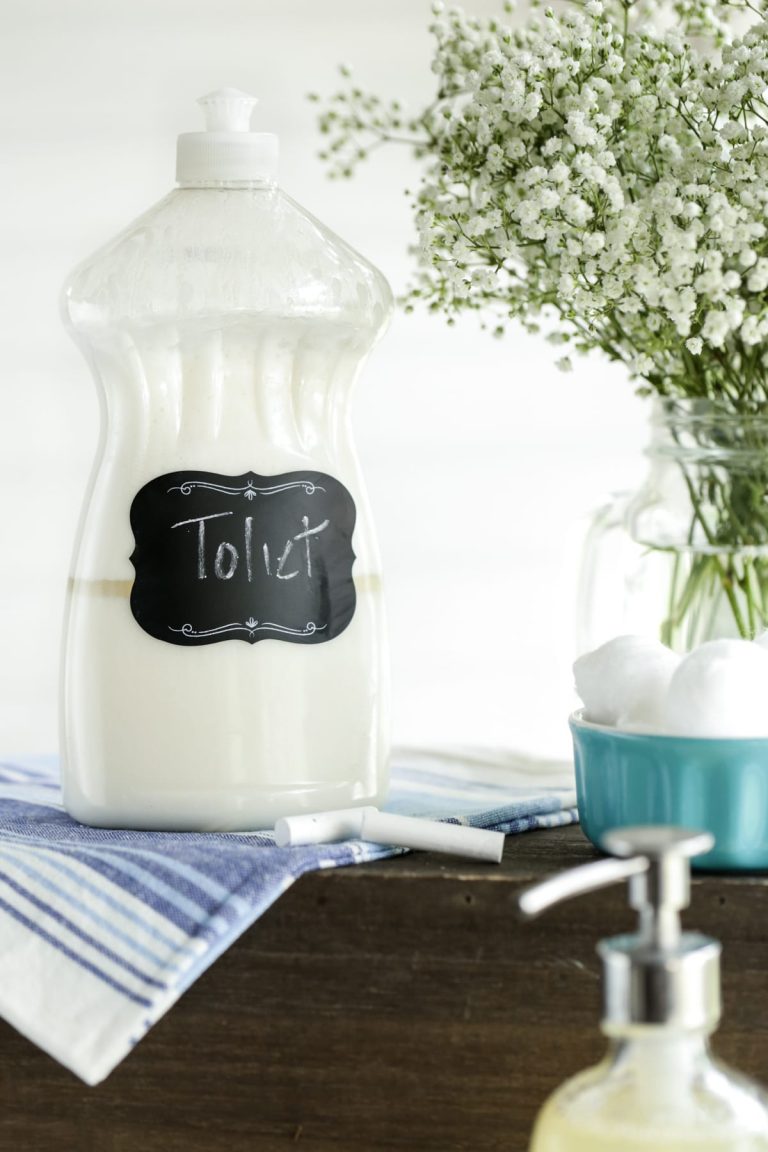
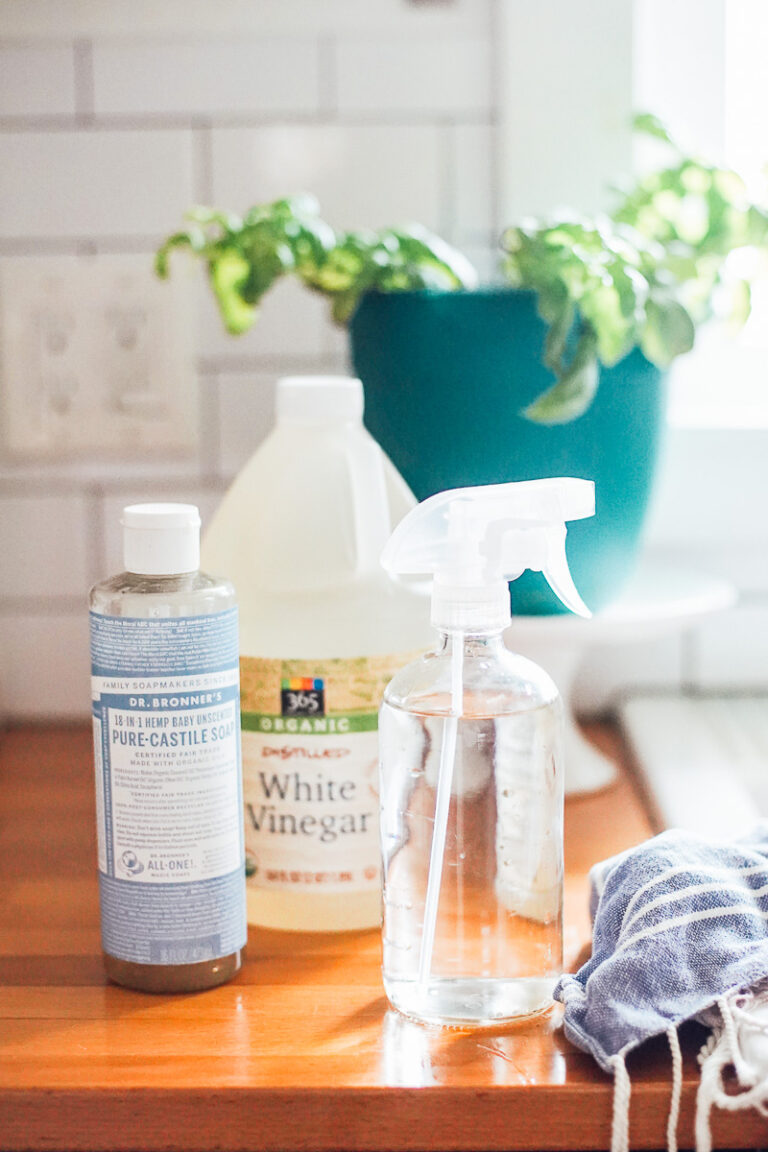
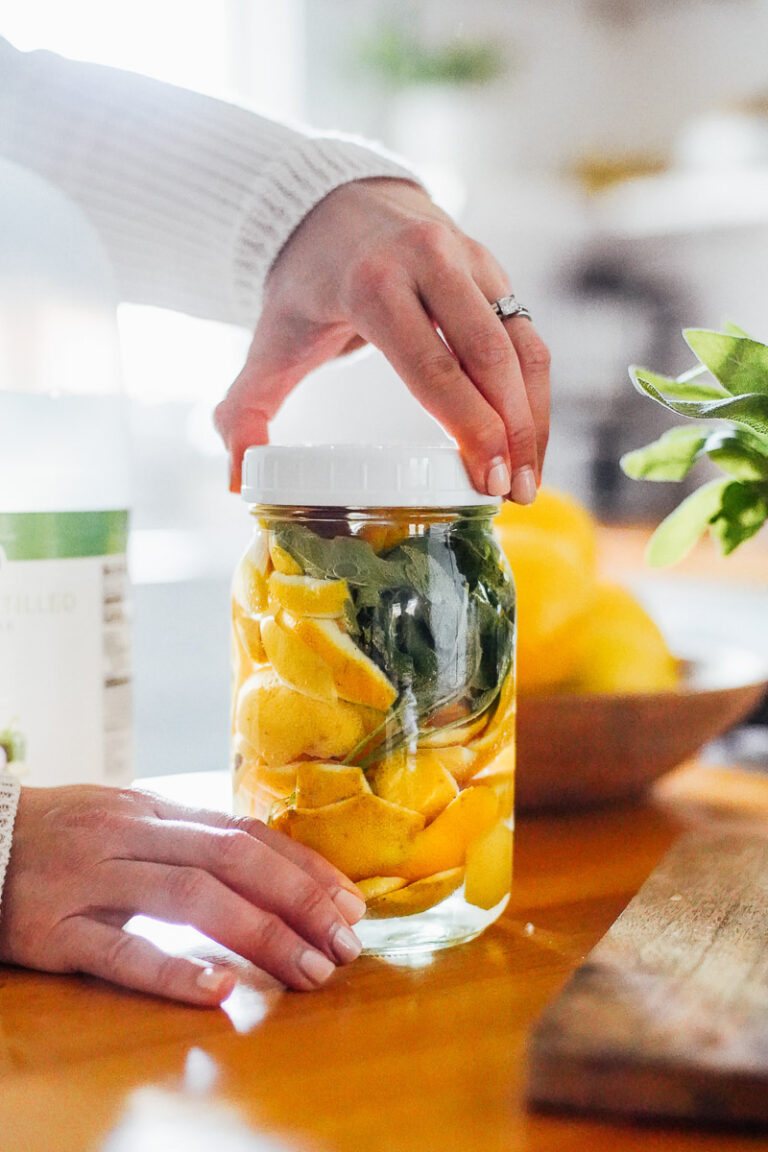
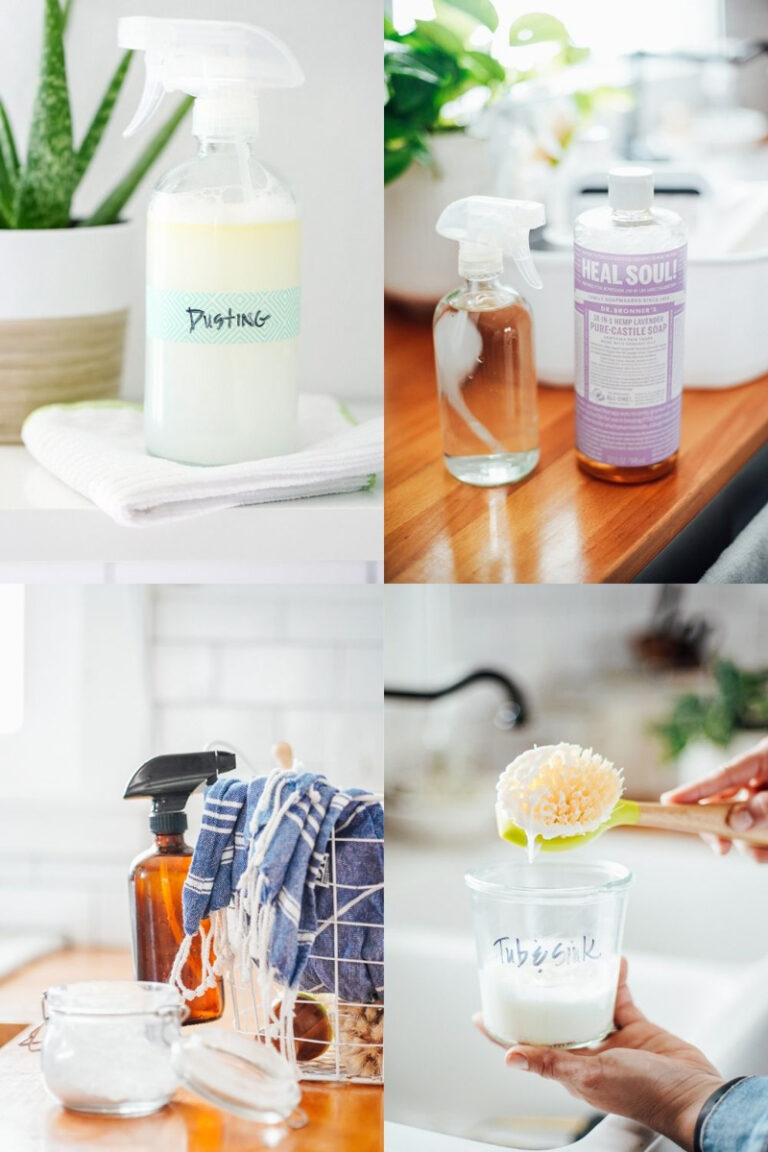

Hi Kristin, I stumbled upon your blog about 6 months ago and I really enjoy it and have tried a few recipes that I love! I made the same concoction like this one that you posted and although it gets things cleaned, it leaves a cloudy residue on every surface…and though I know it’s clean and disinfected, I’m embarrassed at the residue. It almost looks like I just smeared the dirt around! We have really hard water, do you think that could be causing the cloudiness? I have to rinse everything 2 or 3 times, and dry it with a clean dry towel to get it to shine. I’m trying to be frugal and use healthier options to clean with, but this is starting to bring me down. Do you have any ideas or pointers for me? I’m almost ready to go back to buying windex because it’s the only thing that gets the surfaces shiny and look clean. The only other natural product I can use is vinegar, that makes it all shine, but I’d like to smell something good to work with, like this cleaner! Thanks, and keep up the great posts!!!
Hey Karen, I’m so glad you’re enjoying the blog and recipes! I think the cloudy residue is from the castile soap/baking soda mixture and the type of surface you have in the bathroom. Another option is to use the glass cleaner recipe instead: https://livesimply.me/2014/10/14/diy-all-in-one-glass-and-stainless-steel-cleaner/ (perform a small test first on the surface). This is my Windex alternative. The alcohol and vinegar in the solution will provide the cleaning and disinfecting power needed for the bathroom. Another option is to stick with vinegar and use the Citrus Medley Cleaner in this post: https://livesimply.me/2014/03/26/chemical-free-homemade-surface-cleaner-mightynest-giveaway/. Hope this helps :).
Kristin,
I have been using this bathroom cleaner for a while now and just wanted you to know I love it!
Thanks for all your recipes, formulas, tips and guidance. You are appreciated!
P.S. I also use your face lotion!
Awesome, Debbie! I’m so glad you’re enjoying the bathroom cleaner and lotion. Thank you so much for sharing. You’re welcome :)!
This worked amazing cleaning my cook-top! I had a major boil-over of rice pudding and tried numerous scrubbings, dish soap, and a green store bought kitchen cleaner even scraping, but it cemented it’s self on there. After a week of chipping away at it, I got this cleaner out of my bathroom and sprayed it on thick and let it sit for ten to twenty minutes, everything came easily off with a little plastic scraper and a microfiber towel. I am very impressed!
That’s awesome, Bethany! I hate when that happens on my stovetop. I’m so glad this worked!!
Still using this cleaner recipe for kitchen and bathroom along with your toilet cleaner for soft scrubbing power. You are my natural cleaning hero and I always recommend this recipe. Thanks a million!
Yay, Bethany! That’s amazing. So happy to hear that.
Hi there! I have been absolutely devouring your wonderul blog ever since I found it a couple of weeks ago!! Now I am finally ready to start putting your recipes to work. Since I am waiting on an order of essential oils, I’m thinking of using a mixture of Dr. Bronner’s tea tree and citrus soaps to replace the essential oils…what do you think?
Thanks for all your hard work!
Hey Erin, I’m so glad you’re enjoying Live Simply!! I think the tea tree and citrus soaps would work great. They won’t fully replace the concentrated essential oils, but they will really clean surfaces.
Hello, I ‘d love to try making this at home! I have two cats at home I heard tea tree and orange oils can be toxic to them. I was wondering its still safe since they are not going to be directly exposed to them and oils will be diluted. Thank you!
This works great and smells so much better than vinegar. My husband should be thrilled.
Woohoo! I’m so glad your hubby will like the new cleaner (and bathroom scent).
Is the baking soda just for extra scrubbing power? Could your all purpose cleaner also be used in the bathroom? Thanks!
Hey Jennifer, The baking soda deodorizes (bye-bye odors!) and adds extra cleaning power. The all-purpose cleaner can be used in the bathroom, too!
I like this “recipe” for soap, and I’ve looked at quite a few. I just wanted to know if you wipe it off after you spray it. And if so, damp or dry cloth? Thanks so much for sharing!
Hey Erin, I wipe the cleaner off with a dry cloth, but I’m sure a damp cloth will work. Enjoy!
Hi, I’ve just started looking into homemade cleaning products and essential oils and I’ve read that essential oils can eat through plastic bottles and that you should use glass instead. Have you found this to be true? Could you tell me Where you get your bottles from? Thanks!!
Hey Natasha, Most essential oil experts recommend essential oil recipes be kept in glass bottles. Personally, I’m okay with plastic if the product will be used quickly (one or two weeks). For most homemade cleaners I use a glass vinegar bottle fitted with a plastic dollar store nozzle. I recently purchased a few glass bottles from Amazon and have been very pleased with the quality! Here’s a link for the bottles I purchased: http://amzn.to/1zEgnVJ. For smaller products I use Mason or Weck jars.
Thank you so much that helps a lot!
You’re welcome, Natasha! I forgot to mention the tutorial for using vinegar bottles: https://livesimply.me/2014/09/18/diy-painted-spray-bottles/. You don’t need to paint them, but the post details how to remove the sticker and glue :).
Hello I found your site yesterday and am very impressed. I also make my own. Leaners, salves and more. I have found Peroxide to be an awesome addition to my cleaners. It helps kill germs and disinfect. I use it diluted about 50/50 or maybe little less and it works great. I also use Essential Oils.
Hey Jaelene, That’s wonderful! Thank you for the peroxide tip…I’ll give it a try.
I have been using something similar on everything. Spray it on the stove and let it sit a few minutes and everything just wipes right off. Spot cleaner on the kitchen floors (necessary with 3 toddlers & a 7 year old!), countertops, dining room table, the baby’s high chair and more.
Perfect, Kristi! I’m glad to hear it’s working so well.
Hi,
I love this idea. Can I substitute another essential oil, such as cinnamon, for the tea tree oil? Or do you know of any oils that would work just as well? I love the idea of this cleaner, I just have a slight aversion to strong tea tree smells, as do my fur babies. :]
Hey Brittni, I think cinnamon would be a great oil to use in place of tea tree oil. Lemon essential oil would also work very well. Enjoy!!
Thank you!
I have had problems with the Castile soap clogging up my sprayers and ruining them. Has anyone else experienced this? Any ideas?
Hey Jenna, I haven’t had this issue (yet) so I can’t speak from direct experience. My initial thought is to try diluting the Castile soap with a bit more with water.
I have had problems but with the baking soda clogging up my sprayers and ruining them too.
Hi Kay,
I’m sorry that is happening. When you add the water, make sure it’s warm so it can dissolve. Also give it a good shake.
Please let me know if this helps you!
LS Team
What do you use to get rid of mildew in the tub/shower? Or does this cleaner tackle it too?
Hi Barbra, We get serious mildew in the grout of our bathtub (Florida and humidity 🙁 ), so I spray a mixture of half vinegar and water first on the mildew areas. I let the vinegar combo sit for few minutes to kill it and then scrub with an extra toothbrush or scrubby brush. Vinegar will kill and clean the bad stuff :). I then follow-up with this cleaner…the baking soda in this recipe finishes the job.
What exactly do the tea tree and orange essential oils do? I know next to nothing about essential oils. Thanks!
Hey Danielle, Tea tree and orange are two of my favorite oils because they kill bacteria which is why they are often used in facial lotions, astringents, and cleaners.
Hi, thanks for sharing this! I have a question, I have peppermint castile soap. Can I use that in this recipe? Do I still need the essential oils? Thanks!
Hey Nicole, Any castile soap will work great! So, the answer is… yes! 🙂 The essential oils help with the cleaning, so I would still use them, especially the tea tree.
Are the essential oils just for smell factor? Or are they part of the cleaning ability?
Hey Nichole, The oils aid in cleaning. You can leave them out and still make a good cleaner, it just won’t be as powerful as the cleaner made with the oils.
This article is way too great. I love the idea of using natural ingredients in cleaning because this is too safe for the family. Thank for sharing this very informative tips. Great Job! Please post some more of this.
Thank you, Mini Clean.
I love this idea! How long does the bathroom cleaner mix last before it loses its cleaning power?
Hey Jody, Thank you! It will last at least a couple of months, if not longer. If you’re planning to store it long-term I would use distilled water to keep the ingredients fresh.
This post could not have come at a more perfect time! I just moved into a new house and have been trying to figure out what I want to use on the bathrooms! Any idea if this cleaner is safe on stone countertops (granite, marble, etc.)?
Perfect timing, Lindsey. I’m not sure about granite or marble. I’d probably test a very small area first before using this on the whole surface. My concern would be the abrasive nature of the baking soda and possibly the orange oil.
Bob Villa has a great granite cleaner.
I have multiple cats, and use your glass cleaner (half vinegar/half water) as a miracle product. Vinigar is a natural cat urine nutralizer, plus the disinfectant alcohol is about perfect. Use bottles of your glass cleaner on just about everything. For you cat people, THIS IS WONDERFUL, CHEAP, AND WORKS.
Wow! That’s amazing, Kathy! Thank you for sharing!
FYI…..tea tree oil is toxic for cats. Try oil of oregeno instead.
Thank you for sharing, Julia!
What is the shelf life of this?
Hey Kate, Using filtered tap water, about a week or two. Using distilled water, I keep it around for about a month. You can also reduce the amounts to make a small bottle frequently.
Is there any additional ingredient that I could add to make it last longer than one month? Thanks in advance
Hey Patricia, You can add a preservative. This post goes into more detail about preservatives and lotion (some of the options may work for a water-based product like this, too):https://thenerdyfarmwife.com/natural-preservatives-for-homemade-lotion-and-cream/. I personally keep my cleaners as long as I feel comfortable, so the “use by” date is up to you.
Just curious….Does it smell or look different if it “goes bad”?
Hey Sarah, You’ll notice growth, extra cloudiness, or an off smell. I haven’t had this happen, yet. As long as it’s used within a few weeks (and distilled water is used), it generally doesn’t go bad that quickly.
Is it important to have this cleaner in a glass bottle?
Can I just use the soap, baking soda, and lemon essential oil or is the tea tree oil necessary?
Hey Tasherra, Yes, you can. 🙂